Onward and Upward | Staircase Refresh Has Abundant Options
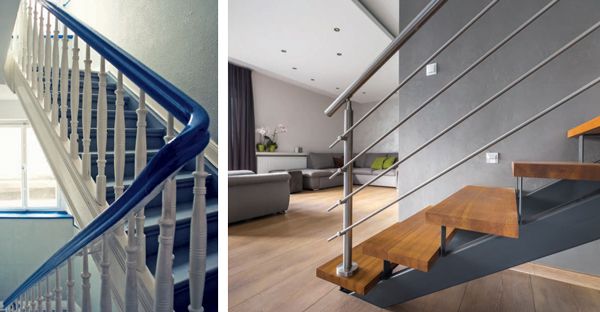
Thomas Jefferson believed stairs to be a waste of space. Instead of designing a grand staircase for Monticello, his home outside Charlottesville, Jefferson tucked two stairways out of sight, accessible via interior corridors. Unlike Jefferson, many homeowners have to accept a staircase that is on display to those who walk through the front door. Given their prominence, it’s wise to consider how stairs can enhance—not detract from—your home’s overall appeal.
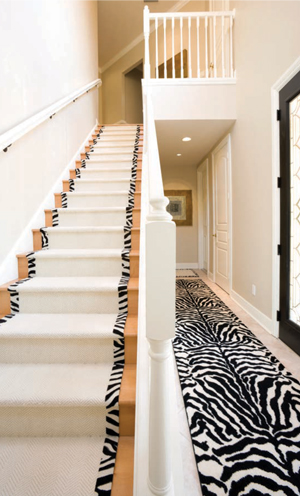 To carpet or not to carpet?
To carpet or not to carpet?
Carpeting on stairs is a personal preference. If you’re worried about slipping, it’s good to have something atop the tread—the flat horizontal surface of the step. Carpeting may also be the best option if the house’s stairs were constructed from lesser-quality wood, which may not be appealing when uncovered.
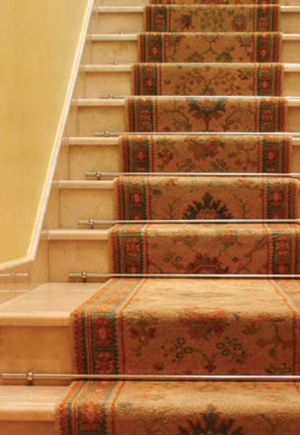 If the wood is good quality, but you want to muffle sound, a, runner will cover the center of each tread, leaving the ends exposed. For a formal look, you can add stair rods, which are metal bars that fit where the tread meets the riser, the vertical face of the stair. Stair rods are purely decorative—the runner is secured with glue and/or staples—and can cost anywhere from $15 to $60 per rod.
If the wood is good quality, but you want to muffle sound, a, runner will cover the center of each tread, leaving the ends exposed. For a formal look, you can add stair rods, which are metal bars that fit where the tread meets the riser, the vertical face of the stair. Stair rods are purely decorative—the runner is secured with glue and/or staples—and can cost anywhere from $15 to $60 per rod.
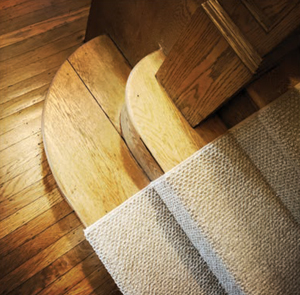 The cost of carpeting or installing a runner can vary widely, just as it does with carpet elsewhere in the house. If your primary concern is to minimize slips, adhesive stair treads are an option. These are individual pieces of carpet or even rubber that are peel-and-stick (though the addition of double-sided carpet tape is advised). Pricing on stair treads varies widely; the thicker and more decorative the tread, the higher the cost (think $5–$25 each). For a formal look, consider bullnose treads, where the front edge wraps around the lip of the stair; these can cost as much as $40 each.
The cost of carpeting or installing a runner can vary widely, just as it does with carpet elsewhere in the house. If your primary concern is to minimize slips, adhesive stair treads are an option. These are individual pieces of carpet or even rubber that are peel-and-stick (though the addition of double-sided carpet tape is advised). Pricing on stair treads varies widely; the thicker and more decorative the tread, the higher the cost (think $5–$25 each). For a formal look, consider bullnose treads, where the front edge wraps around the lip of the stair; these can cost as much as $40 each.
Hanging on
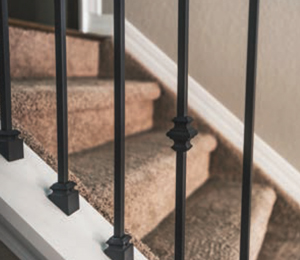 Terminology for the hardware around a staircase is a little confusing. Balustrade encompasses the railing and the posts underneath. Banister often refers to the handrail atop the supporting posts, but it can also mean balustrade. Balusters are the posts underneath the rail; these can be spindle (turned wood), pickets (square or rectangular), or columns (rounded or square). Often, balusters are wood, but they can be wrought iron, steel or aluminum.
Terminology for the hardware around a staircase is a little confusing. Balustrade encompasses the railing and the posts underneath. Banister often refers to the handrail atop the supporting posts, but it can also mean balustrade. Balusters are the posts underneath the rail; these can be spindle (turned wood), pickets (square or rectangular), or columns (rounded or square). Often, balusters are wood, but they can be wrought iron, steel or aluminum.
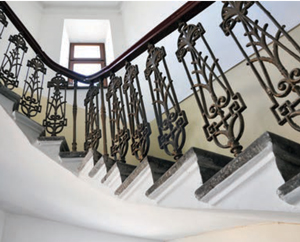 To change the look of a staircase, you can switch out the elements of the balustrade, moving away from traditional Colonial to a transitional or even modern appearance. Be sure to keep the overall decor of your house in mind; you don’t want a “country casual” staircase surrounded by Victorian details and furniture.
To change the look of a staircase, you can switch out the elements of the balustrade, moving away from traditional Colonial to a transitional or even modern appearance. Be sure to keep the overall decor of your house in mind; you don’t want a “country casual” staircase surrounded by Victorian details and furniture.
The eye’s the limit For the stairs themselves, there are myriad creative ways a staircase can be transformed. A classic approach is to simply paint (or cover with painted plywood) the risers white. A white riser against a dark wood tread creates a clean, crisp look. For extra visual interest, add a runner with a fun or unexpected pattern: bold stripes, faux animal print, or oversized floral in lieu of the standard Persian.
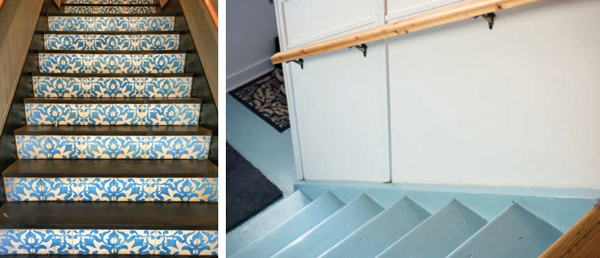
For something more adventurous, consider painting each riser a different color or a different shade of the same color. An ombre staircase, in which the color intensifies (or lightens) as it ascends, is both fun and easy. Select a relatively dark hue and thin it with basic white, creating the shades needed. For a taller staircase, try a pyramid pattern, where the color moves from light to dark and then back to light again.
If the stairs lead to a playroom or are in a garage, go bright with rainbow stairs, a unique and random line-up of bright colors, or even vertical color stripes in varying widths, using painter’s tape to keep lines crisp.
For a formal approach, you can stencil a pattern on the riser, whether geometric or floral—floating, along the edges, or top-to-bottom. When considering geometric or repeating patterns, pay close attention to the color and size of the images. Small patterns that have significant color contrasts can create the optical illusion of movement; you don’t want a pattern that “swims” as you’re walking up the stairs.
If you don’t want to paint… Tiling the risers is an Old World approach, and this might require a professional for cutting and even placement. An easy and economical option is to apply vinyl stickers, which can look like tile but don’t have the weight, cost or permanence. Be sure to use vinyl stickers, however, as regular adhesive stickers are more difficult to remove.
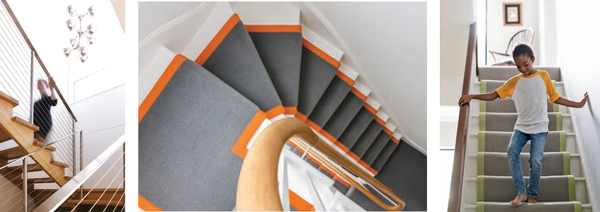
As with any other area of your house, the staircase can reflect your personality and support your home design aesthetic. Oftentimes, a stair update is a relatively small project that is easily managed, is cost-effective, and brings an unexpected impact in a much-used space. ✦
Balustrade, Banister, Carpeting, columns, pickets, riser, runner, spindle, stair rods, staircase






